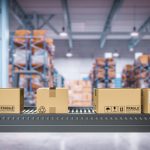Direct-to-Consumer (D2C) eCommerce sales keep increasing. Good news for retailers, logistics and warehouse operators, but not necessarily if many items are sent back after receipt. David Priestman reports on how reverse logistics can be made less challenging.
“Amazon-style returns for D2C brands,” is what ReturnBear’s CEO, Sylvia Ng (pictured, below), told me her company can offer when we met at Manifest Las Vegas. International ecommerce returns management is the forte and niche of the Canadian company she leads. “Some buyers know they will return items when they buy them,” she states.
Returns rates in the D2C brand sector average a whopping 35%, with clothing and fashion being the largest sector for returns by far. “Electronics, home goods, and beauty products tend to have high return rates,” Ng adds. “Electronic goods often face issues with buyer’s remorse or compatibility concerns, while homeware goods like furniture can suffer from size mismatches.”

Sylvia Ng
Returns cause inevitable supply chain headaches, but how can they be ameliorated? As a 4PL (fourth party logistics operator) ReturnBear, based in Toronto, work with brands to lessen the costs and complications of returned, unwanted goods. In 2024, ReturnBear surpassed the 1 million returns milestone, processing over 1 million returns through its end-to-end system, which includes a returns portal and automation software.
“Merchants face high costs and returns take too long,” says Ng, adding that sustainability issues also press brands and retailers to lessen the, often, long load back. When a consumer wants to return one item or more and be refunded a retailer merchant first has to provide them with a shipping address label. Ideally, the consumer should get an instant refund but do the first mile of the return journey – namely to take the re-packaged parcel(s) to a returns centre.
Keeping it Local
If a brand merchant sells in multiple countries ReturnBear keeps the products local. The company has such a facility near us, in Milton Keynes, Buckinghamshire, that receives all British returned items and keeps them in the UK for re-despatching. When the item(s) are received back at the returns centre they can be checked, inspected and re-packaged or tagged ready for delivery to the next customer, without going all the way back to the retailer’s warehouse or factory, which is usually far from the consumer and often in a different country.
“Merchants can easily sell in a hundred countries overnight using global selling platforms,” Ng tells me, “but there is no easy way to get returns back. Our expansion into the UK market is part of our vision to be the first global end-to-end platform for single-day returns. The new MK facility is run in partnership with Reship and the expansion coincides with us extending our support to clients.” By entering the UK market, ReturnBear can now offer a suite of reverse logistics solutions to enable merchant retailers to provide good experiences without a direct local presence.
“Cross-border eCommerce continues to outpace domestic growth, driven by increasing consumer confidence in international shopping and the expansion of global fulfilment networks,” Ng says. “However, challenges like returns, duties, tariffs, and logistics complexities remain key pain points – ones that we help brands navigate.” There is a need to streamline returns processes and improve customer experience.
ReturnBear offer merchants package-free and label-free convenient return points as an alternative to returning items by post. The company claims that as much as half of return logistics costs can be saved by this method. There are over 1000 such return drop-off points in Canada, covering 80% of the population there. “While Canada is our primary operational base, we operate in the US, UK and Australia with dedicated returns warehouses that help merchants receive, verify, and process returns. Where applicable we forward fulfil the returned inventory to local customers, preventing the need for merchants to ship product back to centralized warehouses that are typically across borders or oceans. With this service we reduce the distance travelled by returns by 40% and therefore reduce emissions by the same amount. We’re seeing strong demand in the US, UK, and Australia for this service which is very aligned with our strategic expansion.”
Stopping Fraud
Cross border returns, with pre-clearance, commercial invoices and shipping manifests are provided. What about bulk shipments? “Our batch consolidation model allows brands to reduce the cost and environmental impact of returns by grouping multiple returned items together before they are shipped back to a warehouse or resale location. Instead of processing individual return shipments, items are collected at regional hubs and shipped in bulk – lowering logistics costs, reducing carbon footprint, and improving efficiency.”
“Fraud prevention is important, so we verify that the correct item has been returned if a refund has been actioned by the scanning of the returns shipping label,” Ng explains. “Merchants can easily sell in a hundred countries overnight using global selling platforms. But there is no easy way to get returns back. Our expansion into the UK market is part of our vision to be the first global end-to-end platform for single-day returns,” she added. “Consumers check for convenient returns before buying, and merchants must meet consumers’ expectations to grow in local markets. ReturnBear provides a simple way to do that.” And we all must keep the consumer happy, right?
The post When the Consumer Says ‘Return’ appeared first on Logistics Business.




